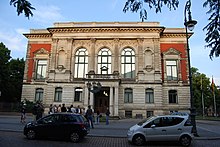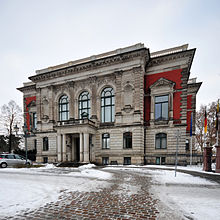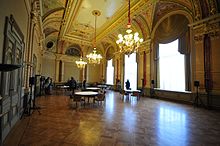Palais am Fürstenwall
The Palais am Fürstenwall is one of the most important historical buildings in Magdeburg . Erected between 1889 and 1893 near Magdeburg Cathedral and the Fürstenwall in what was then Augustastraße - now: Hegelstraße 42 - the building, which is relatively young in terms of architectural history, now houses the State Chancellery of Saxony-Anhalt .
history
Originally, the Palais am Fürstenwall, as the headquarters of the General Command, was one of the most important administrative buildings in Prussia, where Kaiser Wilhelm II and his family regularly stayed.
prehistory
Until the end of the 19th century, the property was part of Magdeburg's extensive fortifications, in the expansion of which Prince Leopold von Anhalt-Dessau - the "Old Dessauer" - played a key role (Magdeburg's fortress commander from 1702 to 1747). In 1874, the walls were almost completely torn down because new weapon technology had rendered its previous protective function ineffective in a short time.
A new, different concept applied to the new building area: it was planned from the start as a “showcase street”, as a residential address for the upper class of society, lawyers and industrialists. The street was built wider, the houses were built at a greater distance from one another and with fewer floors. Their architectural style, with its elaborately designed facades, was based on Italian palazzi.
In addition to its function as a residential area, it also served as the seat of important authorities. The first house on the square was the Palais am Fürstenwall: built for the General Command of the IV Army Corps , the representative sandstone-brick building was lavishly designed inside and out.
Use from 1893
After the inauguration on May 8, 1893, General Karl-Eduard von Hänisch , Prussian General Commander of the IV Army Corps, the highest military authority for the administrative districts of Magdeburg and Merseburg as well as the Duchies of Anhalt and Saxony-Altenburg , moved from the previous office at Domplatz 5 in the ground floor.
Probably the most prominent resident was Paul von Hindenburg : from 1904 to 1911 he was General Commandant in the Palais am Fürstenwall, his successor was Friedrich Sixt von Armin . For 27 years the General Command used the Palais am Fürstenwall as an office building. The last commander living there was a lieutenant general named Sonntag from 1918 to 1920. Tax officials used the house from 1921 to 1943.
From 1945
After the Second World War, US military leaders first resided in the building, then the Soviet military administration. After this was relocated to Halle, the Magdeburger Rundfunk moved in for a few months. From 1946 to 1949 the SED district and district executive board was housed there. From 1949 it was used culturally as the "House of German-Soviet Friendship ". On June 25, 1953, it was given the name " Erich Weinert House of German-Soviet Friendship".
Since 1990
In 1990 the house belonged to the federal government. The purchase contract was signed on June 30, 1993. The purchase price was 2.84 million euros - the market value was around 11.3 million euros. For this, the state had to undertake to prepare the property for the state administration within three years and to use it for this purpose for another 15 years.
The complete renovation was essentially completed from June 1991 to the end of 1995, and the rooms received their fine-tuning by 2000. 21 restorers, 50 painters, three photographers, a chemist and a surveyor were involved in the major project, who had to expose around 2,000 square meters of wall and ceiling space.
From 2001 to 2005 the palace was used by the Ministry of Justice . Since the end of 2005, the Palais am Fürstenwall has once again served as the state chancellery and official seat of the Prime Minister of Saxony-Anhalt .
building
The Palais am Fürstenwall is the main work of the Magdeburg architect Paul Ochs . The free-standing building in the style of the Italian High Renaissance stands out clearly from neighboring buildings. The three-story, two-story house facing Hegelstrasse is separate from the closed house fronts in the neighborhood.
As was common in the early days, it was built based on the Italian model. The shapes of the respective style - Renaissance and partly Baroque - were then industrially manufactured according to individual taste and attached to the masonry. But the exterior style was mostly missing inside the houses. It was different in the Palais am Fürstenwall: The military administration was obviously able to spend extensive financial resources on the new building, and so it was possible for the architect to plan generously and to have valuable materials processed, which is evident from the impressive interior of the building.
This can also be seen in the design of the facade: sandstone and brick surfaces alternate, each of the four sides of the house is different from the others. The front is characterized by tiled external axes that frame a five-part sandstone surface that protrudes from the building with the three large arched windows. The surface is structured by the different materials as well as by this protrusion called Risalit .
Sightseeing
The Palais am Fürstenwall is open to interested visitors on two Saturdays a month; a telephone registration is required for the free one-hour tour. For example, you can see the ballroom, the cabinet room, the fireplace room and the office of the Prime Minister, and the history of the building is told.
literature
- Ingelore Buchholz: Magdeburg as it was. Düsseldorf 1997
- Thomas Groll, Peter Schmidt: Fourth Interim Report - On some selected aspects of the restoration work on the inner shell of the Palais am Fürstenwall, Magdeburg. Magdeburg 1995
- State capital Magdeburg (ed.): Glass design Magdeburg. Magdeburg 2002
- State capital Magdeburg (ed.): Magdeburg - architecture and urban development. Hall 2001
- Magistrate of the City of Magdeburg (ed.): Magdeburg. Berlin 1927
- Hans-Joachim Mrusek: Magdeburg. Leipzig 1966
- Sabine Tacke: Palais am Fürstenwall - past and present. Magdeburg 2006
- Gotthard Voß: The Palais am Fürstenwall. In: Preservation of monuments in Saxony-Anhalt , issue 1/1996
Web links
- https://www.youtube.com/watch?v=UFbFqq-Q5AI
- http://www.mp.sachsen-anhalt.de/fileadmin/Bibliothek/Ppolitik_und_Verwaltung/StK/MP/Publikationsliste/Flyer_Palais.pdf
- http://www.stk.sachsen-anhalt.de/fileadmin/Bibliothek/Ppolitik_und_Verwaltung/StK/STK/Dokumente/Palais_ohne_Einleitung.pdf
- http://www.stk.sachsen-anhalt.de/staatskanzlei-und-ministerium-fuer-kultur/
Individual evidence
- ↑ Sabine Tacke: Palais am Fürstenwall - past and present. Ministry for Construction and Transport of the State of Saxony-Anhalt (ed.), Magdeburg 2006, without ISBN
- ↑ Gotthard Voss: The palace on the Fürstenwall. In: Preservation of monuments in Saxony-Anhalt , issue 1/1996
- ↑ http://www.stk.sachsen-anhalt.de/service/fuehrungen-fuer-besucher/
Coordinates: 52 ° 7 '20.4 " N , 11 ° 38' 0.2" E




